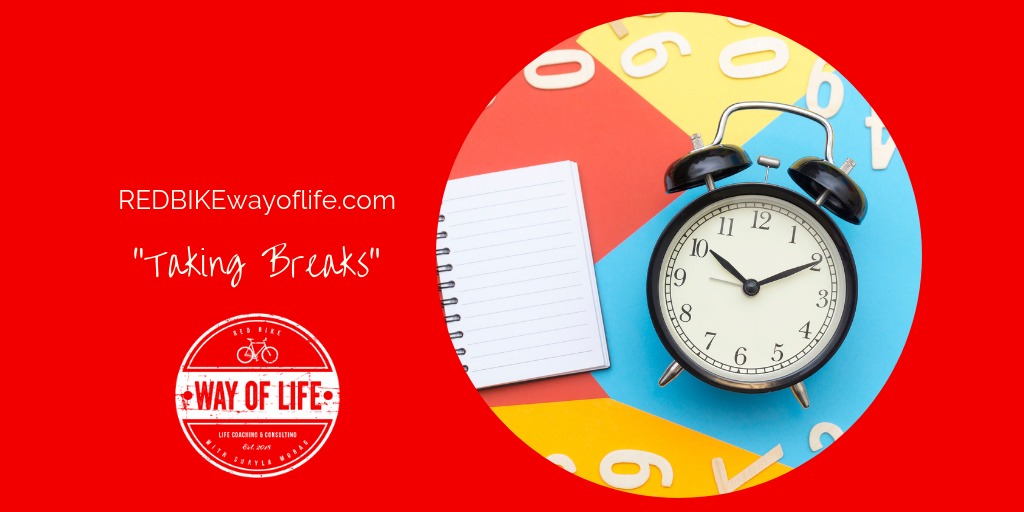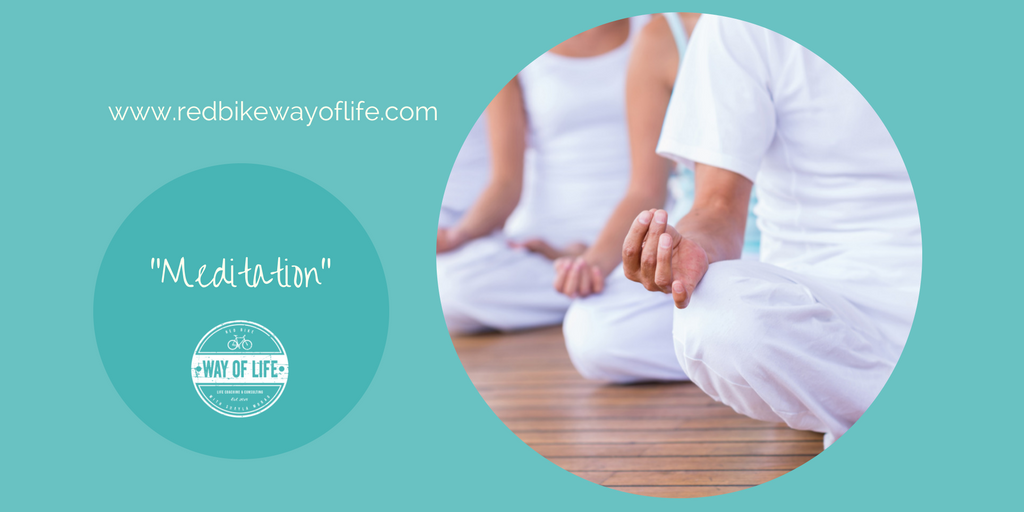
by Shayla Morag | Jun 18, 2019 | Balance, Meditation, Mindfulness, Self Care, Stress Management, The Red Bike Way
The Western world views breaks as a tool to promote laziness. But your effectiveness and efficiency will improve if you take regular breaks. You can work more intently and for more hours each day if you’ll give yourself a break at least once per hour. You won’t just get more done, you’ll be happier and less stressed, too.
Learn about the following 7 advantages of taking breaks:
1. You’ll get more done. Try a little experiment at work. First, spend a day attempting to do nothing but work for the entire day and note how much you accomplish. The following day, focus on your work for 30 minutes and then take a 5-minute break. Notice how much more you accomplish.
This applies to physical activities as well. Studies have shown the average marathon runners actually complete the race faster and more comfortably if they take regular walking breaks of up to a mile each.
2. You’ll feel much better at the end of the day. While performing the previous experiment, notice how you feel physically and mentally at the end of the day. You’ll feel nearly as good at the end of the day as you did at the beginning if you take breaks. Without breaks, you’ll feel exhausted.
3. The quality of your work is improved. The ability to focus is limited. Your mind begins to wander at some point. The quality of your work is compromised when your focus begins to wane.
Taking regular breaks is an effective way to ensure the quality of your work doesn’t suffer.
4. Breaks provide opportunities for evaluation. It’s important to regularly assess if you’re working effectively. If you put your head down and never look up, you can find yourself lost in the weeds. A break is an opportunity to re-evaluate the situation.
5. Taking a break can lower your stress. It’s important to intermittently disengage from any activity that causes stress. Your ability to work is compromised as your stress rises beyond a certain level
6. Breaks help to prevent boredom. Studies suggest that it’s more effective to regularly disengage and reengage with goals rather than focusing on them for long periods of time. The same idea applies to your work. Avoid spending too much time on one task before taking a break. You’ll maintain a higher level of interest in your work.
7. You can use your breaks to get other things done. Imagine how much you can accomplish with 8 or more 10-minute breaks each day. You could spend those 10 minutes performing an exercise or two, meditating, staying in contact with friends and family, tidying up, paying bills, or practicing the violin.
A break is a change in activity. Breaks don’t have to be spent daydreaming, though that’s not a bad way to spend a break.
You might be wondering how long a break should be and how frequently they should be taken. Science has an answer. For most people, the ideal break schedule is a 5-minute break every 30 minutes or a 10-minute break every 60 minutes. It can also be helpful to take a longer break every 2-3 hours.
Try a few different schedules and see what works for you. As a general rule, tasks that require more brainpower or muscle power require more frequent breaks.
Breaks are enjoyable way to add hours to your day. Your output will increase and you’ll also enjoy your free time more since you won’t be exhausted. Give yourself a break today and enjoy the many benefits taking regular breaks provides.

by Shayla Morag | Mar 09, 2018 | Meditation, Mindfulness, Self Care, The Red Bike Way
Meditation, particularly mindfulness meditation, has become extremely popular over the last few years. While meditation can be very simple, there are several common mistakes and misconceptions about meditation that you’ll want to avoid if you’re new to the practice. Getting started on the right foot increases the odds of maintaining your meditation practice and getting the most benefits from it.
Use these 16 practical tips to avoid meditation pitfalls:
1. Sit up straight. Slouching may be comfortable for a couple of minutes, but it takes more strength than you think to support poor posture. Sit up straight and let your skeleton support your weight.
2. Start slowly. Just a couple of minutes is enough to start. There are two good reasons for this. It’s easier to be compliant when you only have to sit for three minutes at a time. It’s also challenging to meditate for an extended period of time if you’re not experienced
3. Meditate multiple times each day. By sitting for just a couple of minutes, you should have time to sit for multiple sessions. You might want to try meditating for a few minutes each hour.
4. It’s all about the breath. Your breath connects you to the moment and helps to keep your mind focused. The breath isn’t something to be focused on intensely, rather it acts as an anchor to maintain awareness of the present.
5. Count if necessary. If you’re struggling to maintain awareness of your breath, count your breaths. Count each inhalation until you’ve reached five and then start over.
6. Keep your eyes opened slightly. It’s easier for your mind to wander from the present if your eyes are closed. Keep your gaze lowered and soft.
7. Acknowledge thoughts but avoid dwelling on them. All thoughts should be treated the same. They’re just phenomena passing through. Let them go and return your attention to the breath.
8. Be patient. It seems like it should be easy to concentrate for a few minutes, but the mind likes to stay busy. It’s a challenging habit to break. Be patient.
9. Sit comfortably. It’s not necessary to sit with your legs folded up like a pretzel. Any position that can be held comfortably for the planned time is good enough.
10. Use a timer. Without a timer, you’ll find yourself worrying about the time and continue to peek at the clock. Set a reliable timer and you won’t be as preoccupied with the time.
11. Increase your meditation time by 5 minutes each week. Avoid the temptation to progress too quickly. Ideally, you’ll look forward to your meditation sessions. Progressing too quickly causes restlessness and agitation.
12. Consider getting expert assistance. There are many free opportunities to meditate with others. Look for local meetups or contact your local Buddhist temple. With so many people meditating, you’re bound to find an expert willing to help.
13. Take every opportunity to meditate. Meditating at home under perfect conditions is great practice, but the ultimate goal is to have the ability to meditate anywhere. A skilled meditator can meditate on a 99-degree packed, loud, smelly, subway.
14. Be persistent. If you’re meditating each day with the full intention of improving, you’ll eventually become a skilled meditator.
15. Stretch first. Your meditation position should be comfortable and easy. If your position feels like a stretch, you won’t be comfortable. Stretch first.
16. There’s no reason to be concerned about your hands. Just place your hands comfortably on your lap. Allowing your hands to be lower can eventually pull down on the shoulders and become uncomfortable.
Meditation can bring you both mental and physical benefits. Use these tips when beginning to meditate and you’ll quickly become skillful at a practice you can enjoy for the rest of your life.

by Shayla Morag | Feb 15, 2018 | Meditation, Self Care, The Red Bike Way
Finding time to meditate can hold you back from beginning your practice. Maybe you try to carve out time, but doctor appointments and business trips get in the way. ?? You can’t find a free hour to sit down. While extended meditation has its benefits, you can also boost your mindfulness with brief breaks of a few minutes or less. Try these tips for calming your mind even on your busiest days.
Brief Meditations: How to Do It!
1. Focus on your breath. Pay attention to your breath as it enters and leaves your nostrils. Follow its path up and down your body. Notice how your abdomen and chest rise and fall when you inhale and exhale deeply
2. Scan your body. Search for areas of tension. Massage your stiff shoulders or hands as you imagine your breath warming and healing them.
3. Observe your thoughts. Check out what’s on your mind without making judgements. Let your mind slow down.
4. Embrace your feelings. You can meditate when you’re feeling content or dealing with major stress. Remember that your emotions are temporary and you decide how to respond to any situation.
5. Watch closely. Lock your eyes onto a chosen object. Pick a candle with a flickering flame or a tree bough swaying in the breeze.
Chant out loud. Fill your mind with a spiritual mantra or an inspiring saying of your own. Repeat it 3 times. Reach out and touch. Many religions use beads to count prayers and maybe even avoid falling asleep. Try wearing a bracelet or holding a charm in your palm as a trigger to bring your mind back to a beautiful and wholesome state.
Brief Meditations: When to Do It!
1. Adjust your commute. Look forward to red lights. Use traffic signals and stop signs as a reminder to breathe.
2. Take a break during meetings. You can stay up to date with your mind at office meetings the same way you check on phone calls and text messages. Ask yourself how you’re feeling while you’re looking to see if a client responded to your last message.
3. Intensify your workouts. Connect with your mind as you build up your body. Meditate for a few minutes on the treadmill or at the swimming pool.
4. Connect with your partner. Make a date with your spouse. Mediate together for a few minutes each morning or before bed.
5. Bond with your kids. Mindfulness exercises can be especially beneficial for children. Make your sessions fun by keeping them short and simple. Throw in some yoga poses, singing, and visualizations that will appeal to your child’s imagination.
6. Line up. Your daily life is probably full of long lines. Next time you’re queuing up for a blockbuster movie or rushing to mail a last-minute present at the post office, remember that meditation will help you pass the time without losing your spot.
7. Skip commercials. Do you enjoy watching 30 seconds of advertising before you can watch the video you clicked on? Hit the mute button, and enjoy the silence that surrounds you.
8. Consume consciously. Do you automatically reach for a donut or a margarita after a rough day? On the other hand, maybe you try to soothe yourself with a little retail therapy. Meditation could be a healthier and less expensive response to stress.
Let go of stress and boost your concentration with a quick meditation session. While instant weight loss products are often disappointing, you can enjoy greater peace of mind in just a few minutes a day. That’s a miracle worth celebrating.




